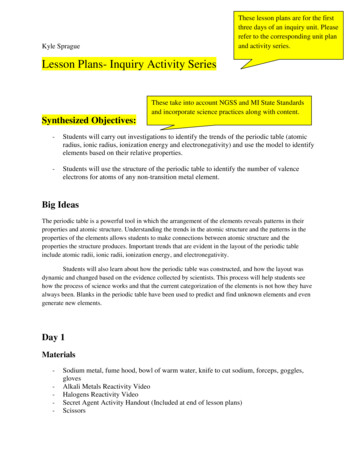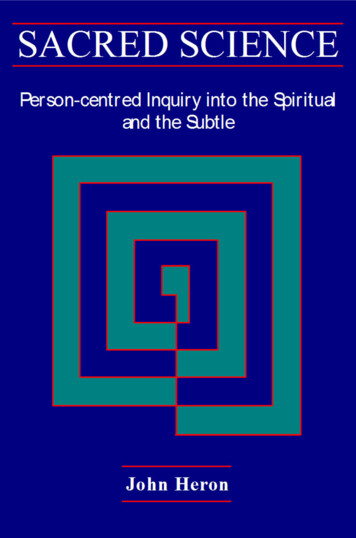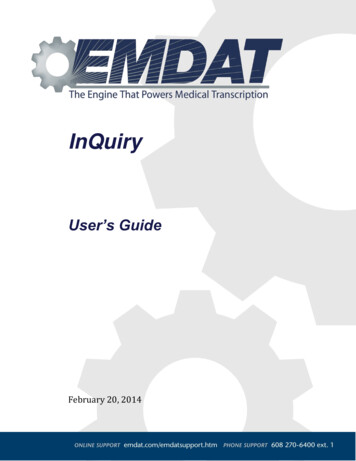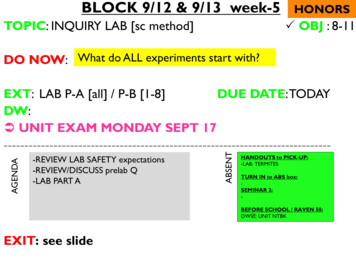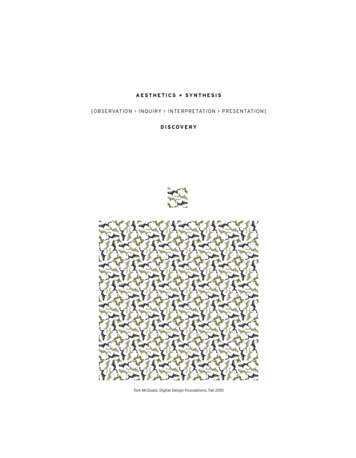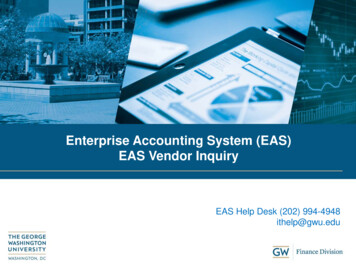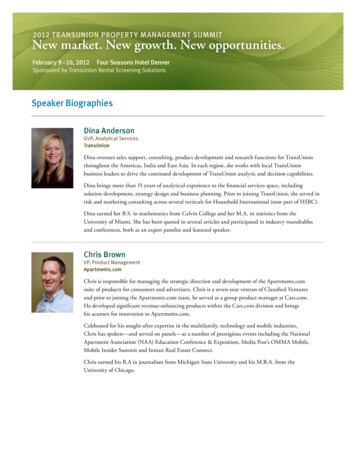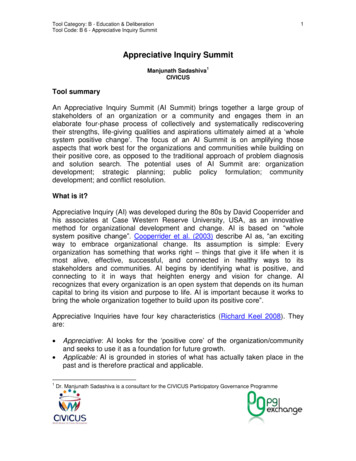
Transcription
1Tool Category: B - Education & DeliberationTool Code: B 6 - Appreciative Inquiry SummitAppreciative Inquiry SummitManjunath SadashivaCIVICUS1Tool summaryAn Appreciative Inquiry Summit (AI Summit) brings together a large group ofstakeholders of an organization or a community and engages them in anelaborate four-phase process of collectively and systematically rediscoveringtheir strengths, life-giving qualities and aspirations ultimately aimed at a „wholesystem positive change‟. The focus of an AI Summit is on amplifying thoseaspects that work best for the organizations and communities while building ontheir positive core, as opposed to the traditional approach of problem diagnosisand solution search. The potential uses of AI Summit are: organizationdevelopment; strategic planning; public policy formulation; communitydevelopment; and conflict resolution.What is it?Appreciative Inquiry (AI) was developed during the 80s by David Cooperrider andhis associates at Case Western Reserve University, USA, as an innovativemethod for organizational development and change. AI is based on “wholesystem positive change”. Cooperrider et al. (2003) describe AI as, “an excitingway to embrace organizational change. Its assumption is simple: Everyorganization has something that works right – things that give it life when it ismost alive, effective, successful, and connected in healthy ways to itsstakeholders and communities. AI begins by identifying what is positive, andconnecting to it in ways that heighten energy and vision for change. AIrecognizes that every organization is an open system that depends on its humancapital to bring its vision and purpose to life. AI is important because it works tobring the whole organization together to build upon its positive core”.Appreciative Inquiries have four key characteristics (Richard Keel 2008). Theyare: 1Appreciative: AI looks for the „positive core‟ of the organization/communityand seeks to use it as a foundation for future growth.Applicable: AI is grounded in stories of what has actually taken place in thepast and is therefore practical and applicable.Dr. Manjunath Sadashiva is a consultant for the CIVICUS Participatory Governance Programme
Tool Category: B - Education & DeliberationTool Code: B 6 - Appreciative Inquiry Summit 2Provocative: AI invites people to take some risks in the way they imagine thefuture and take actions to bring about desired change. With the security andenergy gained from exploring all that is positive about theorganization/community, people feel able to respond with „provocativepropositions‟ about the future.Collaborative: AI always involves the whole organization/community or arepresentative cross-section of members so that all voices are heard andeveryone‟s contribution valued.There are five principles that underpin the AI process. They indicate what isdistinctive about AI and show where its transforming power comes from (RichardKeel 2008): The Constructionist PrincipleThe constructionist principle argues that the language and metaphors peopleuse don‟t just describe the world but they actually create the world. Thuswhat people focus on becomes their reality and that the language people usecreates their reality. AI therefore takes particular care to encourage a positivefocus and encourages the use of positive language because that will leadpeople to construct a positive future together. The Positive PrincipleThe positive principle is at the heart of the AI claim that focusing on thepositive can lead to effective change. The positive principle is expressed inaction by always adopting appreciative language when conducting an AI;encouraging and supporting the people engaged in the inquiry; helpingmembers of the organization/community express the best that they haveexperienced; and building virtuous circles in place of vicious circles. The Simultaneity PrincipleThe simultaneity principle suggests that inquiry and change happen together.Just by asking questions, the participants become engaged in a process ofchange and the nature of the questions affects the nature of the change.Therefore, in AI there is no separate „diagnosis‟ phase. Instead, the changeis seen as starting as soon as the steering group gets together to start askingeach other appreciative questions. The Poetic PrincipleCentral to poetic principle is the belief that organizations/communities aredynamic and change is happening all the time, even if the large-scalepatterns seem reasonably static. AI sees organizations more as a story thana state. The continual conversations and negotiations between people leadto them telling stories about the organization‟s past, present and future.
Tool Category: B - Education & DeliberationTool Code: B 6 - Appreciative Inquiry Summit3Stories are powerful, and both shape those who tell them and arethemselves shaped by the storytellers. The Anticipatory PrincipleThe anticipatory principle argues that images of the future can affect the waywe behave in the present. In particular, if participants have a particularlydesirable image of the future, they are likely to behave in ways that will bringit about. Organizations and communities are not “pushed” by their past asmuch as “pulled” by the collective image they hold of their future.How is it done?AI usually consists of four interrelated phases - the 4-D cycle of Discovery,Dream Design and Destiny. The four phases can be spread out over a longperiod of time, however since the mid-1990s, it has become more common forthe entire process to take place at an „Appreciative Inquiry Summit‟ (AI Summit) a large group event (sometimes involving hundreds or even thousands of people)typically taking place over a period of two to five days. An AI Summit is chosenas a method of intervention when the task requires high levels of participationand cooperation. In an AI Summit, dialogue is the predominant mode ofinteraction with all stakeholders participating actively and having equal voice.Since each organization or community is unique in terms of its internal andexternal relationships, and cultural and geographical mix of its stakeholders,each AI Summit is also unique in its purpose, design, and the task focus.Nevertheless, most AI Summits follow the four phases of Discovery, DreamDesign and Destiny (adapted from Whitney & Cooperrider 2000).1. Phase I: DiscoveryThe discovery phase is preceded by pre-summit preparations entailing taskssuch as preparation of appreciative interview protocols, training of communitymembers if needed on conducting appreciative interviews, organizing logistics,the summit process plan, mobilization of stakeholders, etc. The Discovery phaseaims to answer questions such as: Who are we, individually and collectively?What resources do we bring? What are our core competencies? What hopes anddreams do we have for the future? What are the most hopeful macro trendsimpacting us at this time? What ways can we imagine going forward together?Specific activities include: Setting the task focus - Brief introduction to the context and purpose of themeeting. Appreciative Interviews - All participants engage in one-on-one interviewsorganized around the topics of the meeting (sample questions for appreciative
Tool Category: B - Education & DeliberationTool Code: B 6 - Appreciative Inquiry Summit 4interviews are available at Healthy Kids-Healthy School Project, Richard Keel2008, Imagine Chicago, U.S.A)Who are we at our best - Small group recollection of highlight stories and bestpractices discovered during the interview process.Positive core map – A large group process to illustrate all of the strengths,resources, capabilities, competencies, positive hopes and feelings,relationships, alliances, etc. of the organization.Continuity search – A large group process to create organization, sectorspecific (industry) and global time lines in order to identify factors that havesustained the organization over time and are desirable in the future.2. Phase II: DreamThe Dream phase involves envisioning the organization/community's greatestpotential for positive influence and impact in the world. Dialogues are stimulatedby questions such as: We are in the year 2020 and have just awaken from a longsleep.As you wake up and look around, you see that ourorganization/community is just as you have always wished and dreamed it mightbe. What is happening? How is our organization/community different? Specificactivities include: Sharing of dreams - Small group discussions of dreams collected during theinterview process. Enlivening the dreams - Small groups discuss specific, tangible examples oftheir dream and create creative, metaphorical presentations. Enacting the dreams - Group presentations of dramatic dream enactments tothe large group.3. Phase III: tinganorganization/community in which the positive change core is boldly alive in all ofits strategies, processes, systems, decisions and collaborations. Provocativepropositions or design statements are crafted. They are affirmative statements ofthe future organization/community, stated in the present tense, that stretch thegroup toward its dreams. While they are not statements of specific actions to betaken, they are actionable. A sample provocative proposition might be, “in ourorganization, people have widespread access to knowledge with liberty to makedecisions.” Such a statement, while highly desired, will take a lot of effort tofulfill. It represents the organization‟s commitment to move in that direction.Specific activities include: Creation of the desired design architecture - Large group identifies the designarchitecture best suited to their organization/community.
Tool Category: B - Education & DeliberationTool Code: B 6 - Appreciative Inquiry Summit 5Selection of high impact design elements - Large group draws on interviewsand dreams to select high impact design elements.Crafting of provocative propositions for each design element - Small groupsdraft provocative propositions (design statements) incorporating the positivechange core into the high impact design elements.4. Phase IV – DestinyThe final phase, Destiny, is an invitation to action inspired by the prior phases ofdiscovery, dream and design. For some, this is the day they have been waitingfor, a time to finally get to work on the specifics of what will be done. At this point,personal and group initiative and self-organizing are encouraged. In this phase,the large group‟s commitment to action, and support for those who choose to goforward working on behalf of the whole is demonstrated. Specific activitiesinclude: Generation of possible actions - Small groups brainstorm possible actionsand share with the large group. Selection of inspired actions - Individuals publicly declare their intention foraction and specify cooperation and support needed. Formation of task groups - Open space groups meet to plan next steps forcooperation and task achievement. Large Group Closing
Tool Category: B - Education & DeliberationTool Code: B 6 - Appreciative Inquiry SummitThe 4 –D cyclical process of Appreciative Inquiry SummitSource: http://www.new-paradigm.co.uk/introduction to ai.htm6
Tool Category: B - Education & DeliberationTool Code: B 6 - Appreciative Inquiry Summit7Whitney & Cooperrider 2000 have provided several insights from theirexperiences that need special attention in the organization and implementation ofAI Summits: Holographic beginning: Appreciative interviews in the Discover phase, alsoknown as holographic beginning, allows everyone participating to expresstheir ideas and share their greatest hopes and dreams for the organizationearly on in the meeting. Holographic beginning is extremely important since itallows participants to get to know one another and to quickly feel part of thelarger group within the first hour or two of the summit process.Continuity scan: It enables large groups of people to co-create an image oftheir organization and all that has been successful from a historicalperspective. In the process, everyone learns with excitement and thecollective intelligence of the organization expands. As history is brought intofocus and becomes meaningful, people are more able to imagine possibilitiesfor their collective future.Dislodgement of certainty: AI Summit is based on the premise that change,be it personal or organizational, requires a willingness to let go of certaintyand venture into the unknown. To change, one must be curious and open tonew possibilities, to new ways and to different approaches.Narrative-rich environment: The AI Summit emphasizes narrative forms ofcommunication. Story telling as a means of expressing ideas and interests ishighlighted over lists of facts and information, data presentations and either/ordescriptions. Narrative forms of communication allow values to be expressed,explored and adapted while igniting the human spirit of curiosity andcreativity. They contain seeds of wisdom grounded in experience.From common ground to higher ground: The AI Summit encourages theparticipants to seek the most moving, the most innovative, the mostmeaningful ideas and not the most frequent or most common. The logic isthat if people get excited and inspired talking about something, they will beexcited and inspired to do it.BenefitsAI Summit has gained tremendous popularity over the last two decades owing toits emphasis on “whole system positive change”, which is a radical but refreshingshift from the traditional problem-solving approach. Some of the key benefitsoffered by AI Summit are: The fact that AI Summits can be applied in different cultural and geographicalcontexts, at various levels (from global to local), and in diverse types of(private, public and civil society) organizations and communities.
Tool Category: B - Education & DeliberationTool Code: B 6 - Appreciative Inquiry Summit 8AI Summits can be used with both small (a
1 Appreciative Inquiry Summit Manjunath Sadashiva1 CIVICUS Tool summary An Appreciative Inquiry Summit (AI Summit) brings together a large group of stakeholders of an organization or a community and engages them in an elaborate four-phase process of collectively and systematically rediscovering their strengths, life-giving qualities and aspirations ultimately aimed at a „whole system .


